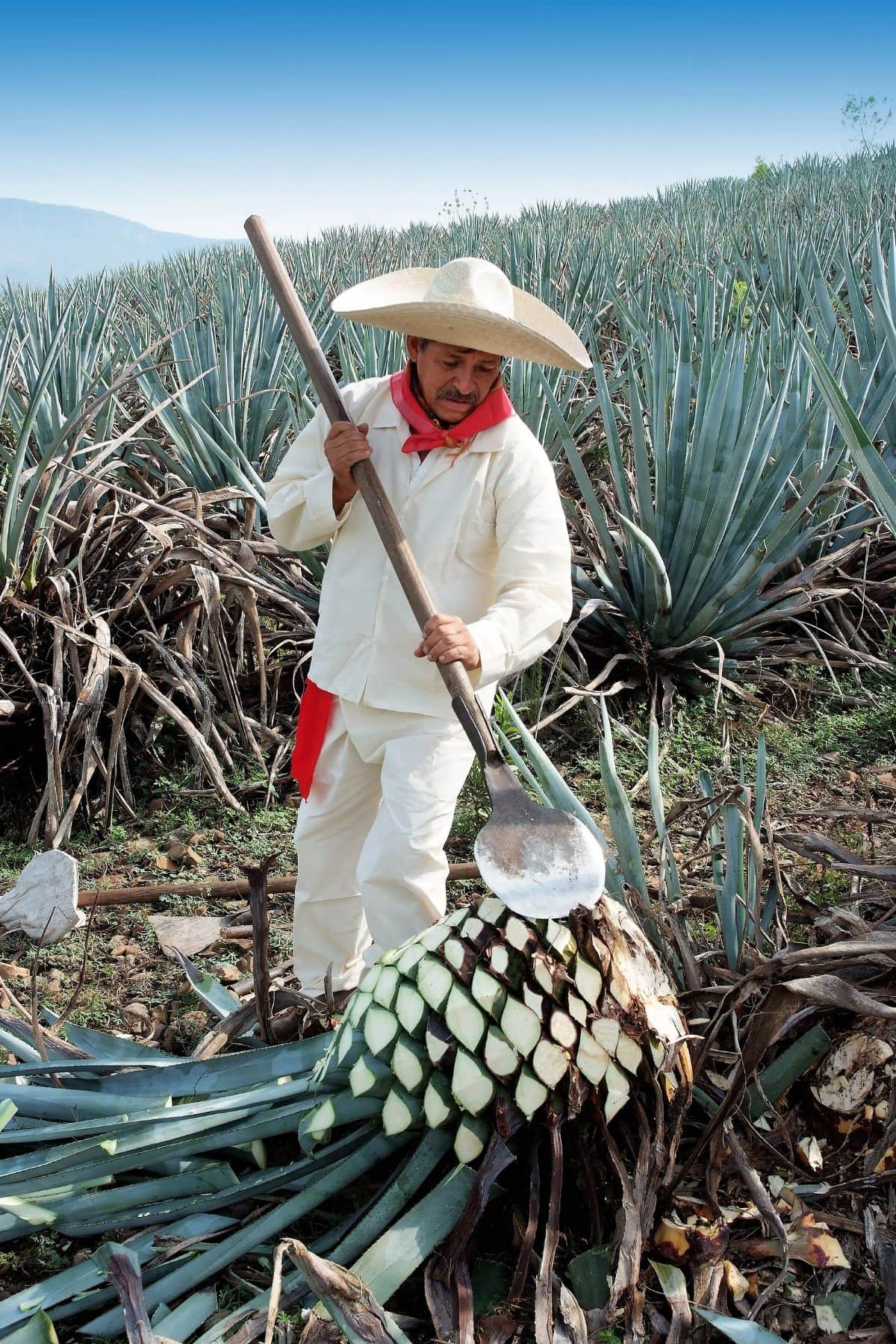What's the difference between tequila and mezcal? All tequila is mezcal, but not all mezcal is tequila. Here we'll show you what's the difference.

Tequila vs. mezcal, two agave spirits celebrated worldwide, both hail from Mexico, reflecting the nation's rich cultural and botanical diversity.
While they share ancestral roots, their distinct production processes and flavor profiles set them apart.
Here we'll talk about the difference between tequila and mezcal in depth.
For more detailed information on each make sure to read about what tequila is and what mezcal is. We go more in-depth on each.
Jump to:
Historical Background
The histories of tequila and mezcal are deeply rooted in the fabric of Mexican culture, dating back to the times of the indigenous peoples long before the Spanish colonization.
Centuries ago, the native civilizations, including the Aztecs, had already been fermenting the sap of the agave plant, creating a ceremonial drink known as "pulque."
This milky, somewhat viscous liquid held religious significance and was often consumed during rituals and special occasions, believed to be a gift from the gods that could bring both spiritual insights and earthly delights.
With the arrival of the Spanish in the 16th century, the art of distillation was introduced to the region.
Combining their knowledge of distillation with the indigenous practice of fermenting agave, a more potent spirit was born – what we now recognize as mezcal.
The term "mezcal" is derived from the Nahuatl words "metl" and "ixcalli," which together mean "oven-cooked agave."
Tequila's evolution is a subset of the mezcal history. The town of Tequila in Jalisco became a focal point for this spirit, primarily due to the abundant Blue agave found in the region.
Over time, and with more defined production methods and regulations, tequila distinguished itself from other mezcals and began its journey towards global recognition.
It's also worth noting that both spirits, especially mezcal, were intertwined with Mexican folklore.
Legends tell of how the lightning struck the agave plant, cooking its core and releasing the fermented liquid, a gift from the gods to the people.
In the centuries that followed, both tequila and mezcal faced periods of prohibition and resurgence but remained enduring symbols of Mexican heritage, resilience, and artistry.
Today, they don't just represent a drink but a storied history of cultural fusion, local traditions, and communal celebrations.
Raw Materials
At the heart of these spirits is the agave plant, a resilient succulent that not only graces the Mexican landscape with its iconic form but has also been deeply interwoven with its culture and traditions.

Tequila: Solely produced from the Blue Weber Agave, or Agave tequilana, this agave type is known for its high sugar content, ideal for the fermentation process.
Its blue-tinted leaves and relatively large size make it a distinctive sight in agave fields.

Mezcal: Boasting a diverse palette of agaves, mezcal can be made from over 30 different species.
Among these, Espadín is the most commonly used due to its larger yields and shorter maturation period.
Others, like Tobalá, are wild-harvested and revered for their unique taste profiles, often resulting in pricier mezcals.
Production Process

How is Tequila Made?
Tequila has a specific way it's made vs mezcal.
Harvesting: Entrusted to the skilled hands of maestro jimadores, these artisans meticulously select mature agave plants, cutting away the spiky leaves to reveal the heart or piña. This labor-intensive task requires precision to avoid damaging the precious core.
Cooking: To break down the blue agave piña's complex carbohydrates, it's baked in traditional stone ovens, brick ovens or more modern autoclaves. This cooking process turns the piña's starches into fermentable sugars, giving it a sweet aroma.
Fermentation & Distillation: With the addition of yeasts, the cooked agave's sugars convert into alcohol. This fermented mixture, known as mosto, undergoes distillation, typically twice, to concentrate and purify the spirit.
Aging: Aging imparts nuanced flavors and colors. Stored in oak barrels, Blanco remains unaged, Reposado rests for 2-12 months, Añejo ages for 1-3 years, while Extra Añejo luxuriates for over 3 years.

How is Mezcal Made?
Mezcal is made using a similar, but different process.
Roasting: Distinctively, mezcal production involves roasting piñas in an earthen underground pit, imbuing the spirit with its smoky essence.
This ritualistic process, spanning several days, involves heating volcanic stones, covering them with moist agave fiber, and layering piñas atop, which are then buried and roasted. (This gives mezcal it's earthy notes.)
Fermentation & Distillation Process: Often relying on wild yeasts, mezcal's fermentation can take place in wooden vats or even animal hides.
Post-fermentation, the alcohol content is amplified through distillation, sometimes in clay pots maintaining age-old traditions.
Varieties: While Joven carries the freshness of an unaged spirit, Reposado and Añejo mezcals absorb flavors from the barrels they're aged in, adding complexity.
Geographic Denomination
The terroir, or the unique environmental conditions of specific regions, profoundly affects the flavor profiles of these Mexican spirits.
Tequila: Its production centers around Jalisco, though regions like Nayarit, Michoacán, Guanajuato, and Tamaulipas also share in this legacy. The red volcanic soil of Jalisco, in particular, lends tequila its mineral-rich taste.
Mezcal: While Oaxaca is undeniably the mezcal heartland, contributing over 90% of production, states like Guerrero, San Luis Potosí, Zacatecas, and Durango also add to the tapestry of mezcal flavors.
Flavor Profiles
Tequila Taste: When you drink tequila, the spectrum of flavors ranges from the grassy, citrusy notes of a Blanco, evoking the freshness of agave, to the caramel, vanilla, and oak undertones of an Añejo or Extra Añejo, reflecting years of barrel aging.
Mezcal Taste: Beyond its signature smokiness, mezcals offer an expansive palette. Espadín might provide notes of cooked agave, tropical fruits, and a hint of pepper. In contrast, a rare Tobalá could surprise with floral undertones, a touch of mint, or even a nuanced earthiness.
How to Enjoy
While both spirits are delightful sipped neat, their versatility shines in cocktails.
Tequila and mezcal, with their rich and varied flavors, offer more than just a sip; they offer an experience.
Appreciating them extends beyond mere consumption — it's about savoring their nuances and versatility.
Sipping Neat
Tequila
Especially for high-quality, aged varieties like Añejo or Extra Añejo, sipping them neat in a tulip-shaped glass (similar to a brandy snifter) allows you to fully embrace their depth and complexity.
Mezcal
Given its wide variety of flavors, a neat sip, particularly from a traditional clay cup or "jicarita", lets you indulge in its smoky essence and underlying notes.
Shots
Popular, especially in lively settings, shots can be a fun way to enjoy these spirits.
While often accompanied by the lick-shoot-suck routine (licking salt off your hand, taking the shot, then biting a slice of lime), purists might argue that this method can overshadow the spirit's intricacies.
Make sure you check out our favorite tequila chasers when taking your shots.
Cocktails
Both spirits seamlessly blend into a myriad of cocktail creations, here are a couple our favorite tequila and mezcal cocktail recipes.
Tequila Cocktails
This cocktails are made using our favorite tequila mixers.
Margarita: A classic mix of tequila, lime juice, and Cointreau or triple sec. Serve it on the rocks or blended with ice.
Tequila Sunrise: Tequila harmonizes with orange juice and grenadine, creating a visually stunning gradient of sunrise colors in a glass.
Pink Paloma: A refreshing blend of tequila, grapefruit soda (or fresh grapefruit juice), lime, and a pinch of salt.
Mexican Mule: This tequila mule is a tequila version of the classic vodka Moscow mule.
Mezcal Cocktails
Mezcalita: A smoky twist on the margarita, where mezcal replaces tequila for a deeper, smokier flavor profile.
Oaxacan Old Fashioned: An inventive take on the classic, with mezcal, tequila, agave nectar, and Angostura bitters.
Smoky Negroni: Swap out gin for mezcal to introduce a smoky undertone to this Italian classic.
With Food
Pairing these spirits with the right dishes can elevate the tasting experience. Fresh ceviche or guacamole can complement the citrusy notes in tequila, while smoky mezcal might find its match in grilled meats or rich mole sauces.
Traditional Rituals
In some indigenous communities, mezcal is traditionally sipped alongside orange slices sprinkled with mezcal worm salt (sal de gusano), a mixture of ground roasted larvae, chilies, and salt.
It enhances the spirit's flavors and pays homage to its roots.
Common Brands
Both tequila and mezcal have enjoyed surges in popularity worldwide, leading to a wider availability of brands in the local liquor store.
Whether you're a novice or a connoisseur, recognizing some of these brands can be a helpful starting point in your exploration.
Tequila
- Jose Cuervo: Perhaps one of the most recognizable names in the tequila industry, Jose Cuervo has been around for over 250 years, offering a range from basic mixtos to high-quality 100% agave tequilas.
- Patrón: A premium brand known for its meticulously crafted tequilas. Their range extends from the crisp Silver to the deep and aged Extra Añejo.
- Don Julio: Another premium brand, Don Julio offers a range of artisanal tequilas with a notable reputation, especially for its Añejo and Reposado varieties.
- Herradura: Established in 1870, it has consistently produced high-quality tequilas, gaining recognition for both its traditional methods and innovative expressions.
- Espolòn: Known for its striking label artwork and its smooth flavor profile, Espolòn has become a favorite for many cocktail enthusiasts.
Mezcal
- Del Maguey: A pioneer in introducing artisanal and traditional mezcals to the global market, Del Maguey offers a variety of single village mezcals, each showcasing the distinct characteristics of its origin.
- Montelobos: Focusing on sustainable and organic production, Montelobos offers a well-balanced mezcal, ideal for those new to the smoky spirit.
- Mezcal Vago: Celebrated for its transparency and artisanal production, Vago offers mezcals from different maestros mezcaleros, each with its unique touch.
- Ilegal Mezcal: With a rebellious origin story of being smuggled into bars, Ilegal has gained popularity for its approachable and varied expressions.
- Los Amantes: A brand with a broad range, Los Amantes provides both young and aged mezcals, each capturing the essence of Oaxaca.
Note: The availability of brands can vary depending on the region and specific store inventory. While the above list includes some common names, local liquor stores might also carry lesser-known gems that are worth exploring.
References and Further Reading
For those eager to delve deeper, books like "Mezcal: The History, Craft & Cocktails of the World's Ultimate Artisanal Spirit" by Emma Janzen or documentaries like "Agave: The Spirit of a Nation" are excellent starting points.
The difference between mezcal and tequila may seem complex, but it's quite simple. I hope this clears up the mezcal vs tequila questions. Cheers!






Leave a Reply